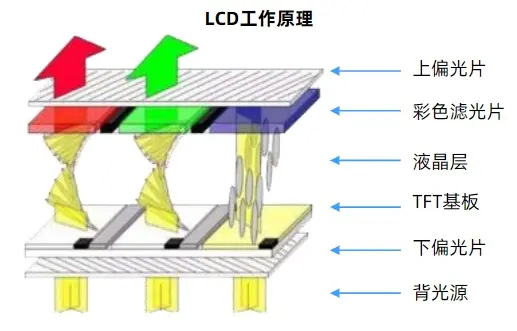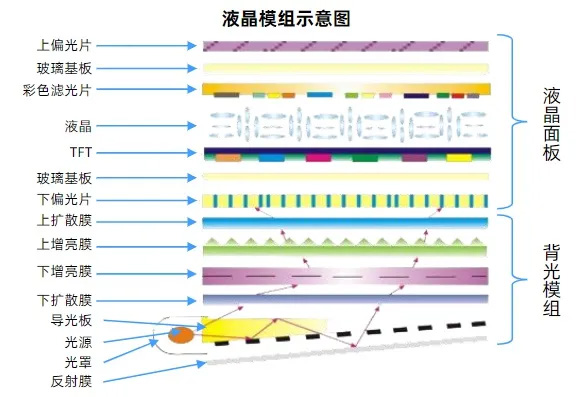Liquid crystal display, referred to as LCD, is a non-self-emitting display, that is, it does not have light-emitting characteristics and needs a backlight module to provide a light source. The structure is to place an LCD box in two parallel glass substrates, a TFT (thin film transistor) is installed on the lower substrate glass, and a color filter is arranged on the upper substrate glass, and the rotation direction of the liquid crystal molecule is controlled by the signal and voltage change on the TFT, so as to achieve the display purpose by controlling whether the polarized light of each pixel is emitted or not.
Core composition - LCD module
Generally, it is composed of a liquid crystal panel and a backlight module, because the liquid crystal in the liquid crystal panel itself does not emit light, an external light source must be provided to achieve the display effect, and the backlight module is the light source providing device for the LCD panel to realize the image display. The backlight module is a key component of the LCD panel, accounting for the highest proportion of the cost of the LCD module. Since the liquid crystal in the LCD panel itself does not emit light, an external light source must be provided to achieve the display effect, and the backlight module is the light source for the LCD panel to achieve image display.

Core composition - backlight module
Optical film refers to the thin and uniform dielectric film layer attached to the surface of the optical device in the process of light propagation path, and through the characteristics of reflection, transmission (refraction) and polarization when layering the dielectric film, it can achieve the special forms of light such as full transmission of light or full reflection of light or polarization separation of light in one or more wavelength bands. Commonly used optical films include high reflection film, anti-reflection film, filter film, color filter film, brightness enhancement film, concentrating film, diffusion film, polarizing film, etc.

• Diffusion film:
It is mainly composed of three layers, including the lowest scratch-resistant layer, the middle transparent PET substrate layer and the uppermost diffusion layer. The diffusion film works by incident light from the lowest scratch-resistant layer, penetrates the highly transparent PET substrate, and then is scattered by the diffuse particles dispersed in the diffusion coating to form a uniform flood light source. Most of the diffuse particles are spherical, and their function is similar to that of a convex lens, and the light is focused into a certain exit angle when passing through these particles, so as to enhance the brightness of the outgoing light. In addition, particles of different particle sizes in the diffusion layer ensure that light does not shine directly out of the diffusion film, thus having an atomization effect.
• Brightness enhancement film:
Brightness enhancement film is a transparent optical film, composed of three layers, the bottom layer of the light surface needs to provide a certain haze through the back coating, the middle layer is a transparent PET substrate layer, and the top layer of the gloss surface is a micro-prism structure. The light source passes through the light surface and the transparent PET substrate layer, and when the prism layer passes through the fine prism structure of its surface, the light intensity distribution will be controlled through refraction, total reflection, light accumulation, etc., and then the light scattered by the light source is concentrated to the front, and the unused light outside the viewing angle is recycled through the reflection of light, reducing the loss of light, and improving the overall brightness and uniformity, which has the effect of increasing brightness and controlling the viewing angle of the LCD panel display.
•Reflective film:
Generally placed at the bottom of the backlight module, the main purpose is to reflect the light leaked below through the light guide plate and return it to the panel side, so as to reduce light loss and increase the brightness.
Yotoon (HK) Limited
Contact: Mr. Lin
Email: sales@LCD-DIY.com
Address:
Rm.1902, Easey Comm. Bldg., 253-261 Hennessy Road,Wanchai, Hong Kong.
ShenZhen KinFin Technology Co., Ltd
Contact:Ms. Lucy
Mobile:+8618126037668
Email:sales@kinfin.com
Address:D1, Shuangjinhui Industrial City, Fuhai Street, Bao'an, Shenzhen, China
